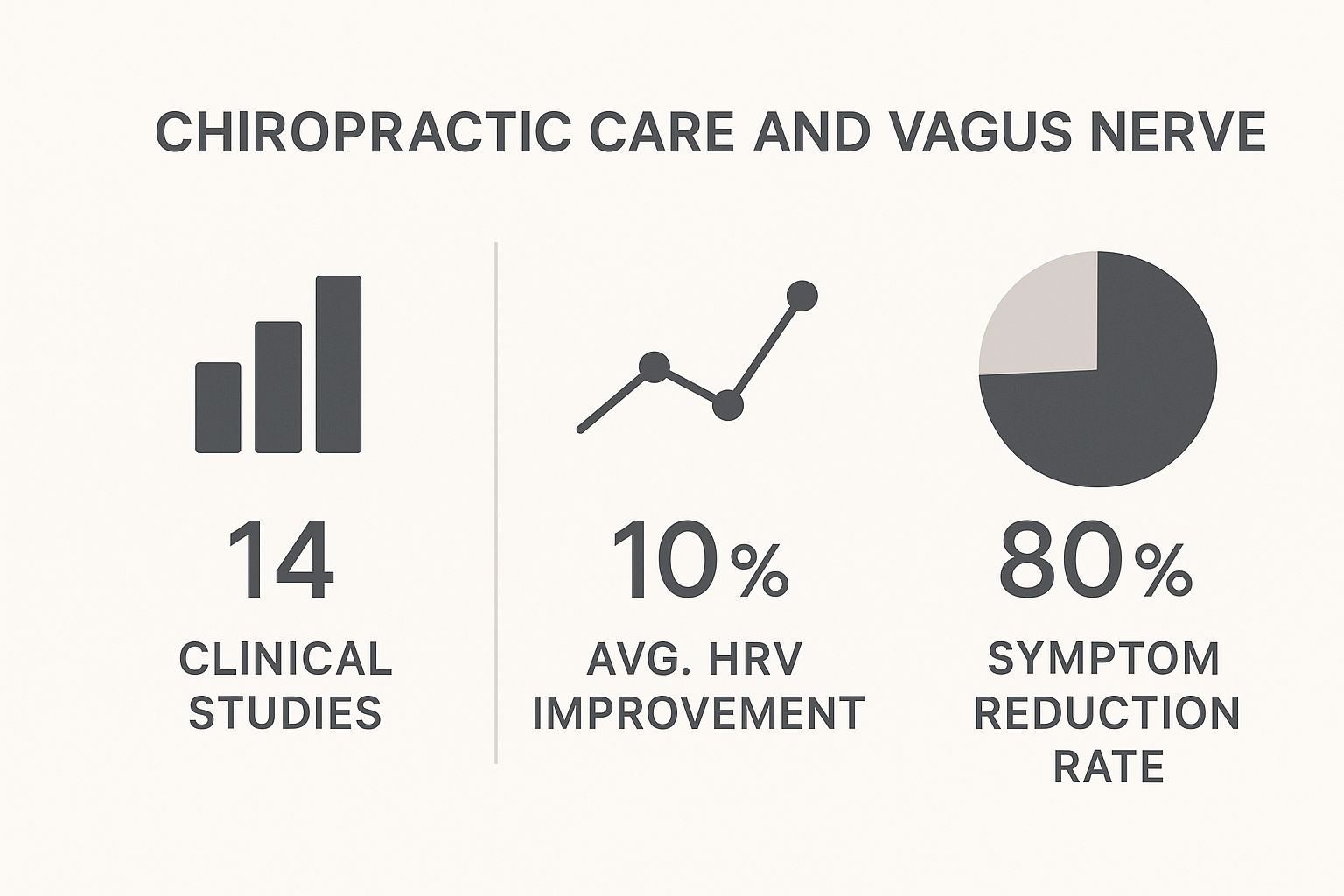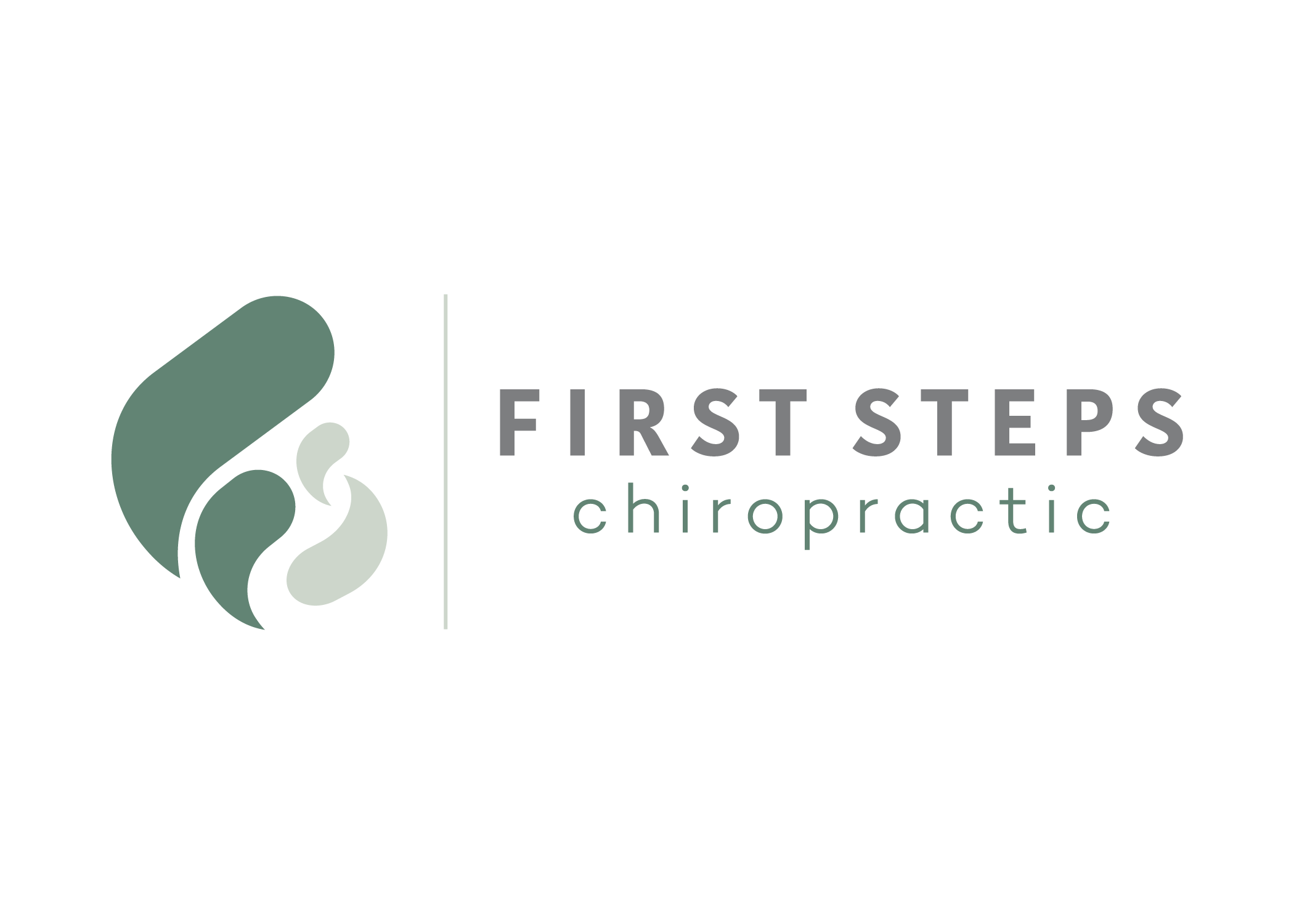Chiropractic care is a powerful way to improve vagus nerve function. How? By addressing misalignments in the spine—especially in the upper neck—that can get in the way of the nerve’s signals. The goal is to help your body shift from a constant state of stress to one of calm and relaxation, which is the entire basis of the vagus nerve and chiropractic connection. When we optimize this critical communication pathway, we’re really just supporting the body’s innate ability to regulate and heal itself.
Understanding the Vagus Nerve: Your Body's Superhighway

Picture a massive, intricate highway running directly from your brainstem, down through your chest, and into your abdomen. That's your vagus nerve. It's the longest cranial nerve you have and the main driver of your parasympathetic nervous system—the system that’s responsible for calming you down.
Think of it as your body’s master control switch. When a stressful event happens, your sympathetic nervous system fires up, triggering that all-too-familiar "fight or flight" response. The vagus nerve is what hits the brakes, sending the "all clear" signal to your body that the danger is gone and it's time to "rest and digest."
What Is Vagal Tone?
Just like a muscle, the effectiveness of this nerve can be measured. We call this measurement vagal tone.
Someone with high vagal tone can bounce back quickly after stress; their body is resilient and regulates itself efficiently. On the other hand, low vagal tone means that "fight or flight" switch stays stuck in the "on" position for far too long, leaving you feeling anxious, overwhelmed, and stuck.
Good vagal tone is directly linked to better physical and mental health. It has a hand in everything from your heart rate and digestion to your mood and how well you handle the daily grind.
Boosting your vagal tone is absolutely crucial for your overall well-being. It helps your body manage inflammation, regulate emotions, and maintain that ideal state of balance known as homeostasis. When this critical nerve is working as it should, your entire body reaps the rewards.
The connection between the vagus nerve and chiropractic care is built on this very principle: making sure the nerve's pathway is free and clear, so it can do its vital job without any interference. A healthy, resilient nervous system starts with a well-functioning vagus nerve.
How Your Spine Communicates with Your Nervous System
To understand the powerful link between the vagus nerve and chiropractic care, let’s use a simple analogy. Think of your nervous system as your home’s electrical grid. The brain is the main power station, and the spinal cord is the primary cable that runs through the house, sending power to every single room and appliance. In this picture, your spine is the protective conduit that houses this all-important cable.
So, what happens if there's a kink or blockage in that conduit? The flow of electricity gets disrupted. Lights might flicker, or appliances might not get enough power. This is exactly what happens when your spine is out of alignment. We call these misalignments subluxations, and they create structural stress that interferes with your nervous system’s ability to send and receive clear messages.
This interference is especially problematic in the upper cervical spine—the very top of your neck. The vagus nerve runs right alongside the atlas (C1) and axis (C2) vertebrae. When these two small bones shift out of place, they can put direct or indirect pressure on this critical nerve pathway.
The Impact of Spinal Misalignment
This constant structural stress puts your body into a state of low-level alarm. It’s like a smoke detector that keeps chirping long after the smoke has cleared. This background "noise" forces your sympathetic nervous system—your ‘fight or flight’ response—to stay switched on.
When your body is stuck in this stressed-out mode, the vagus nerve simply can’t do its job. The parasympathetic ‘rest and digest’ system gets pushed to the back burner, making it incredibly difficult for your body to calm down, heal, and function at its best. This can show up as:
- Feeling constantly on edge or anxious.
- Poor sleep quality or trouble winding down at night.
- Digestive problems like bloating or irregularity.
- A feeling that you just can’t handle everyday stress.
The spine isn't just a stack of bones; it's the armor and communication superhighway for your central nervous system. A misalignment is more than just a structural problem—it's a neurological one that can prevent your body from finding balance.
This is the central idea behind neurologically-focused chiropractic care. Our goal isn't just to get rid of neck or back pain. It’s about removing the interference that’s holding your nervous system hostage. You can learn more about how chiropractic care supports the nervous system in our detailed guide.
By restoring proper alignment, especially in the upper neck, we can clear the pathway for the vagus nerve. This helps your body finally turn off the alarm, dial down the ‘fight or flight’ response, and let the ‘rest and digest’ system take over to promote healing and resilience from the inside out.
Boosting Vagal Tone Through Chiropractic Adjustments

When we connect the dots between the spine and the nervous system, the practical side of this comes into focus. The goal of a specific chiropractic adjustment isn't to go in and directly "fix" the vagus nerve itself.
Think of it more like gently unkinking a garden hose. We're removing the structural interference that's holding the nerve back from doing its job.
A precise adjustment, especially in the upper part of the neck, helps bring back proper alignment and movement. This takes the physical stress off the nerve pathways, letting signals flow freely again between the brain and the rest of the body. By clearing up this communication channel, we help the body shift out of that high-alert state and back into one of balance and calm.
This is the heart of the vagus nerve and chiropractic connection. It’s all about letting your body’s own master control system get back to work without anything getting in its way.
Measuring the Change in Vagal Tone
So, how can we be sure these adjustments are actually helping the vagus nerve? We measure it. The gold standard for checking in on vagal tone is Heart Rate Variability (HRV).
HRV isn’t just about how fast your heart is beating. It’s about the tiny, millisecond-long variations in time between each heartbeat. A healthy, adaptable nervous system has high variability—it's flexible. On the flip side, low variability often signals a system that's stuck in a chronic stress response.
Heart Rate Variability is a powerful window into your nervous system's resilience. Higher HRV is a key indicator of good vagal tone, showing that your body can efficiently shift gears from stress to relaxation.
The Science Behind HRV Improvement
More and more research is backing up the link between chiropractic care and better HRV numbers. We use specific measurements to track these changes, and each one tells us a piece of the story about your nervous system's health.
- SDNN (Standard Deviation of Normal-to-Normal intervals): This gives us a look at your overall autonomic nervous system balance.
- RMSSD (Root Mean Square of Successive Differences): This one zeros in on your parasympathetic ("rest and digest") activity specifically.
A 2022 study really brought this to light. It found that key HRV metrics like SDNN and RMSSD shot up significantly in a group using a specialized chiropractic surface, pointing directly to a boost in vagal activity. This shows a measurable improvement in the body's ability to rest and recover. You can read more about the study's findings on vagal nerve activity.
This kind of data shows that chiropractic adjustments can create real, quantifiable improvements in how your nervous system is working. By supporting the primary mechanisms of your parasympathetic nervous system, this care helps unlock your body’s own ability to heal, regulate, and thrive. For a deeper dive, check out our guide on parasympathetic nervous system stimulation.
Measuring Your Progress with Heart Rate Variability
It’s one thing to feel better or notice you’re sleeping more soundly, but how can we be sure that chiropractic adjustments are truly improving your nervous system? We need to look beyond subjective feelings and get into the data. That’s where a powerful, non-invasive tool called Heart Rate Variability (HRV) comes in.
HRV gives us a clear, numerical snapshot of how resilient your nervous system is. Instead of just going by how you feel, this data shows us precisely how your body is responding to care. It takes the benefits from something you feel and turns them into something you can actually see.
Think of it as a fitness tracker, but for your nervous system. We take a baseline measurement when you start your care plan and then re-evaluate over time, allowing us to watch your HRV numbers improve. This increase is a direct reflection of a stronger, more adaptable nervous system and a healthier vagal tone.
From Subjective Feelings to Objective Data
Seeing these numbers change is incredibly empowering for patients. When you tell us you’re sleeping better, your digestion has improved, or you’re handling stress with more ease, we can often pull up your chart and show you the direct correlation with your improved HRV scores. It’s the scientific proof that your body is shifting from a state of chronic stress to one of balance and healing.
This infographic breaks down some key metrics showing the growing body of evidence connecting chiropractic care, nervous system function, and real-world patient outcomes.

The data tells a clear story: as scientific interest in this area grows, the measurable improvements in both nervous system function and patient well-being become harder to ignore.
A simple way to understand vagal tone is to look at the signs associated with a nervous system that's stuck in "fight or flight" versus one that is balanced and resilient.
Signs of Poor vs. Healthy Vagal Tone
| Indicator | Associated with Poor Vagal Tone | Associated with Healthy Vagal Tone |
|---|---|---|
| Heart Rate | Consistently elevated or erratic resting heart rate. | Lower, stable resting heart rate. |
| Digestion | Frequent bloating, constipation, or IBS-like symptoms. | Regular, comfortable digestion. |
| Sleep | Difficulty falling or staying asleep; waking up tired. | Deep, restorative sleep cycles. |
| Mood | High anxiety, irritability, or feeling overwhelmed. | Calm demeanor, emotional resilience. |
| Immunity | Prone to frequent colds and illnesses. | Strong immune function. |
| Recovery | Slow recovery from exercise or stress. | Quick bounce-back from physical and mental stress. |
| HRV Score | Low HRV, indicating a lack of adaptability. | High HRV, showing a flexible, adaptive nervous system. |
This table highlights why improving vagal tone isn't just about one symptom—it's about upgrading how your entire body functions day-to-day.
A Real-World Example of HRV Improvement
The science backs this up with specific, documented cases. For example, we know that chiropractic care can produce statistically significant improvements in vagal tone as measured by HRV. One compelling case series followed a patient over six months of spinal adjustments while tracking their progress.
The patient’s SD IBI—a key indicator of vagal influence—jumped from a baseline of 45.42 to an impressive 128.58 at the six-month mark. That’s a massive enhancement in their parasympathetic ("rest and digest") activity. You can dig into these findings on nervous system improvement for a closer look.
This isn't just about feeling good; it's about functioning better. HRV gives us the concrete evidence that specific, neurologically-focused adjustments are helping your body build resilience from the inside out.
By measuring what matters, we can tailor a care plan that’s perfectly suited to your body’s unique needs. This data-driven approach ensures we aren't just masking symptoms but getting to the root cause, allowing us to celebrate every real milestone on your journey toward optimal health.
How a Healthy Vagus Nerve Shows Up in Real Life
Measurable data like improved HRV scores are great, but what really matters is how you feel day-to-day. When we talk about boosting your vagal tone, we're really talking about unlocking a better quality of life. The connection between the vagus nerve and chiropractic care isn't just theoretical—it translates directly into tangible health wins you can actually see and feel.
A balanced nervous system isn’t just a cool scientific concept; it’s the bedrock of your overall well-being. When your body can smoothly shift from a high-alert, stressed-out state to one of calm and healing, the positive changes can be profound. It’s all about building resilience from the inside out.
From Fewer Headaches to Better Digestion
One of the first things many of our patients report is a dramatic drop in chronic pain, especially headaches and migraines. Because the vagus nerve is a key player in managing inflammation and pain signals, improving its function can bring immense relief. This is especially true when misalignments in the neck are part of the picture.
But the benefits go way beyond just pain relief. A well-regulated vagus nerve is also essential for a happy gut. It’s the master controller of digestion, and when its signals are clear and strong, issues like bloating, constipation, and general discomfort often begin to fade. This gut-brain connection is incredibly powerful, influencing everything from how you absorb nutrients to your mood.
A Calmer Mind and a More Resilient Body
Think of a healthy vagus nerve as your body’s built-in anxiety-reducer. By helping your system switch over to "rest and digest" mode more easily, you’ll likely notice:
- Reduced Anxiety: A greater sense of calm and less reactivity to the things that used to stress you out.
- Better Sleep: Falling asleep faster and enjoying deeper, more restorative rest that actually leaves you feeling refreshed.
- Lower Inflammation: The vagus nerve helps put the brakes on the body's inflammatory response, which is linked to countless chronic health issues.
- Improved Mood: A more stable and positive emotional state as your nervous system finally finds its equilibrium.
The ultimate goal here is to move beyond just chasing symptoms. It's about creating a nervous system so resilient and adaptable that your body can heal and regulate itself far more effectively.
Clinical results back up these life-changing improvements. For instance, in cases involving dysfunction in the neck, combining chiropractic adjustments with vagus nerve stimulation has led to some incredible outcomes. One study showed a 76.92% improvement in neck disability and a 100% reduction in headache intensity over just ten weeks. Headache frequency dropped from several times a week to zero. You can dive into these powerful patient outcomes in the full study.
Ultimately, enhancing your vagal tone through chiropractic care is about getting your life back. It’s the difference between just surviving your days and truly thriving in them, armed with a nervous system that is calm, connected, and ready for whatever comes next.
Finding a Vagus Nerve Focused Chiropractor

If you're ready to see how chiropractic care can support your nervous system, finding the right professional is the most important first step. The truth is, not all chiropractors have the same focus. You’ll want to look for one who emphasizes neurologically-focused care and truly understands the intricate relationship between the vagus nerve and chiropractic adjustments.
The initial consultation is where this difference really shines through. A practitioner focused on nervous system health will go far beyond just asking about your pain. They’ll want to know about your stress levels, sleep quality, digestion, and overall emotional well-being.
What to Expect During Your First Visit
A key distinction is the use of advanced diagnostic tools. You should expect more than just a standard physical exam. Many neurologically-focused chiropractors use technology like Insight Scans, which includes Heart Rate Variability (HRV) testing. This gives them a concrete, measurable baseline of your nervous system's current state.
These scans provide objective data on how well your body is actually adapting to stress. To get a better sense of this technology, you can learn more about the role of a chiropractic nerve scan in modern care. This data-driven approach is what allows the chiropractor to create a care plan that’s genuinely personalized to you.
Your initial visit should feel like a comprehensive health investigation, not just a quick symptom check-in. The real goal is to uncover the root cause of any nervous system interference, setting the stage for targeted and effective care.
Key Questions to Ask a Potential Chiropractor
To make sure you find the right fit, it’s a great idea to come prepared with a few questions. This empowers you to make an informed decision and feel completely confident in the provider you choose.
- Do you use HRV or other scans to measure nervous system function? This tells you they rely on objective data to track progress, not just how you feel on a given day.
- What specific techniques do you use? You're listening for gentle, precise methods like Torque Release Technique (TRT), especially for the crucial upper cervical spine.
- How do you tailor care plans for nervous system health versus just pain relief? Their answer will immediately reveal their core philosophy and approach to care.
Finding a partner who listens deeply and uses precise tools is crucial for your journey toward better nervous system balance and improved vagal tone.
Common Questions Answered
How Many Sessions Will It Take to Improve My Vagal Tone?
This is a question we get all the time, and the honest answer is: it’s different for everyone. How many visits you’ll need really depends on your unique situation. We consider things like your specific health challenges, how long your nervous system has been stuck in a state of stress, and what your ultimate wellness goals are.
Some people notice a shift within just a few appointments, while others need a more consistent, long-term plan to see lasting change. We don't guess—we use objective tools like HRV scans to actually track your progress. This lets us see how your nervous system is adapting and allows us to adjust your care plan as you improve.
Are Vagus Nerve Adjustments Safe?
Absolutely, as long as they are performed by a chiropractor who is qualified and specifically trained in this area. The adjustments we use to improve vagal function are incredibly gentle and precise, especially when we’re working with the upper neck area.
It's important to understand that the goal is not to directly manipulate the nerve itself. Instead, we correct the subtle spinal misalignments that are causing interference. By clearing up that interference, we allow your nervous system to do its job better all on its own.
Think of chiropractic care as a way to strengthen your body's foundational systems. It supports your overall wellness, rather than replacing medical treatment for specific diseases.
Does Chiropractic Replace Other Treatments?
Not at all. We see chiropractic care as working in partnership with other treatments to help your body heal and regulate itself more effectively. Many of our patients discover that when their nervous system is more balanced, they get even better results from their other therapies.
The ultimate goal is an improved quality of life, and that often means having a collaborative team. We always encourage you to keep all of your healthcare providers in the loop to ensure your care is integrated and supportive from all angles.
At First Steps Chiropractic, we specialize in neurologically-focused care to help your family achieve optimal health and resilience. Schedule a complimentary consultation today!

